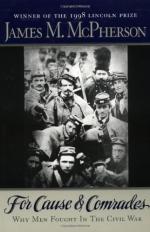
|
| Name: _________________________ | Period: ___________________ |
This test consists of 5 short answer questions, 10 short essay questions, and 1 (of 3) essay topics.
Short Answer Questions
1. In the discussion of the "fighting drunk" terminology, Confederate soldiers were accused of an unlikely combination of whiskey and what?
2. When discussing the mark of honor, which of the following did Civil War soldiers most wish to avoid?
3. As "Chapter 2: We Were in Earnest" opens, McPherson says that another name for the Civil War is what?
4. Toward the end of "Chapter 6: A Band of Brothers," McPherson quotes which of the following theorists in relation to ideal primary groups?
5. Which of the following was a major in the 19th Iowa, described in "Chapter 4: If I Flinched I Was Ruined," who would walk and let injured men ride his horse?
Short Essay Questions
1. In the discussion of leadership, what do the soldiers' letters indicate about the differences in leadership between the Confederate and Union armies?
2. In the discussion of religion, how did Christian soldiers reconcile the war with the commandment to "turn the other cheek"?
3. How did the Calvinist doctrine of predestination factor into soldiers' lives in the discussion of religion?
4. What methods did officers used after they were confronted with undisciplined troops early in the war?
5. What conclusion is reached about the role of religion as a motivating factor at the end of "Chapter 5: Religion is What Makes Brave Soldiers"?
6. Define and explain "rage militaire" as discussed by McPherson in his discussion of the initial impulse that motivated soldiers to fight the Civil War.
7. During the discussion about the adrenaline rush phenomenon, what did soldiers experience once the adrenaline had worn off?
8. How did the Civil War transform irresponsible men into responsible ones as the war got underway?
9. When discussing his framework for the book, what three categories does McPherson say he has used and borrowed from John A. Lynn?
10. As the war got underway, what feeling did soldiers have about "safe" positions in the rear of battles?
Essay Topics
Write an essay for ONE of the following topics:
Essay Topic 1
Compare and contrast the effect of the French concept of "rage militaire" during the Civil War with once instance of the same phenomenon in more modern times. In what ways has the effect of this phenomenon on society changed over time? In what ways is the effect the same? Include supporting quotes and information from the text and outside research as necessary.
Essay Topic 2
Analyze and discuss Civil War soldiers' reactions to fear in their first few battles and the accompanying desire to prove themselves as courageous individuals. Include supporting information from the text.
Essay Topic 3
Analyze and discuss the effect religion had on both Union and Confederate soldiers and how their faith influenced their decisions in war. Be sure to include quotes and supporting information from the text.
|
This section contains 1,213 words (approx. 5 pages at 300 words per page) |

|




